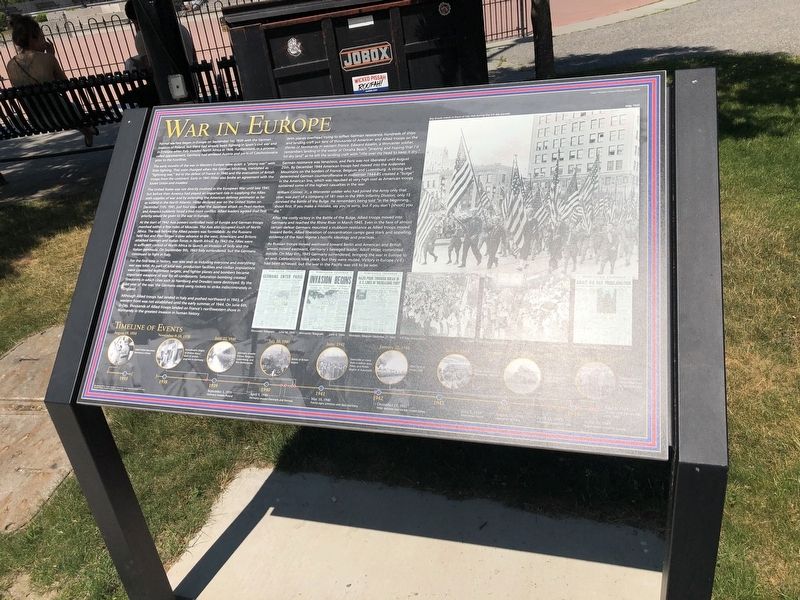Worcester in Worcester County, Massachusetts — The American Northeast (New England)
War in Europe
Formal warfare began in Europe on September 1st, 1939 with the German invasion of Poland, but there had already been fighting in Spain's civil war and in Ethiopia when Italy invaded North Africa in 1936. Furthermore, in a process called appeasement, Germany had annexed Austria and parts of Czechoslovakia prior to the hostilities.
The early months of the war in Western Europe were quiet: a "phony war" with little fighting. That soon changed when the German blitzkrieg, translated as "lighting war," led to the defeat of France in 1940 and the evacuation of British troops from the continent. Early in 1941 Hitler also broke an agreement with the Soviet Union and invaded.
The United States was not directly involved in the European War until late 1941, but before then America had played an important role in supplying the Allies with supplies of war and by extending the American defense perimeter as far as Iceland in the North Atlantic. Hitler declared war on the United States on December 11th, 1941, just four days after the Japanese attack on Pearl Harbor, and America suddenly faced a two-front conflict. Allied leaders agreed that first priority would be given to the war in Europe.
At the start of 1942 Axis powers controlled most of Europe and German troops marched within a few miles of Moscow. The Axis also occupied much of North Africa. The task before the Allied powers was formidable. As the Russians held fast and then began a slow advance to the west, Americans and Britons attacked German and Italian forces in North Africa. By 1943 the Allies were in sufficient control of North Africa to launch an invasion of Sicily and the Italian peninsula. On September 9th, 1943 Italy surrendered, but the Germans continued to fight in Italy.
For the first time in history, war was seen as including everyone and everything: war was total. As part of total war, production facilities and civilian populations were considered legitimate targets, and fighter planes and bombers became important weapons of war for all combatants. Saturation bombing created firestorms in which cities such as Hamburg and Dresden were destroyed. By the last year of the war, the Germans were using rockets to strike indiscriminately in England.
Although troops had landed in Italy and pushed northward in 1943, a western front was not established until the early summer of 1944. On June 6th, D-Day, thousands of Allied troops landed on France's northwestern shore in Normandy in the greatest invasion in human history.
With planes overhead trying to soften German resistance, hundreds of ships and landing craft put tens of thousands of American and Allied troops on the shores of Normandy in
German resistance was tenacious, and Paris was not liberated until August 25th. By December 1944 American troops had moved into the Ardennes Mountains on the borders of France, Belgium and Luxemburg. A strong and determined German counteroffensive in midwinter 1944-45 created a "bulge" in the American line, which was repulsed at very high cost as American troops sustained some of the highest casualties in the war.
William Conner, Jr., a Worcester soldier who had joined the Army only that year, was a part of a company of 181 men in the 99th Infantry Division; only 13 survived the Battle of the Bulge. He remembers being told "in the beginning... shoot first. If you make a mistake, say you're sorry, but if you don't [shoot] you die."
After the costly victory in the Battle of the Bulge, Allied troops moved into Germany and reached the Rhine River in March 1945. Even in the face of almost certain defeat Germans mounted a stubborn resistance as Allied troops moved toward Berlin. Allied liberation of concentration camps gave stark and appalling evidence of the Nazi regime's horrific ideology and practices.
As Russian troops moved westward toward Berlin and American and British armies moved eastward, Germany's besieged leader, Adolf Hitler, committed suicide. On May 6th, 1945 Germany surrendered bringing the war in Europe to an end. Celebrations took place, but they were muted. Victory in Europe (V-E) had been achieved, but the war in the Pacific was still to be won.
Topics. This historical marker is listed in these topic lists: Air & Space • War, World II • Waterways & Vessels. A significant historical month for this entry is March 1945.
Location. 42° 15.749′ N, 71° 48.049′ W. Marker is in Worcester, Massachusetts, in Worcester County. Marker is at the intersection of Front Street and Commercial Street, on the left when traveling west on Front Street. Touch for map. Marker is in this post office area: Worcester MA 01608, United States of America. Touch for directions.
Other nearby markers. At least 8 other markers are within walking distance of this marker. World War II (here, next to this marker); Worcester World War II Memorial (a few steps from this marker); The Home Front (within shouting distance of this marker); War in the Pacific (within shouting distance of this marker); World War II Time Capsule (within shouting distance of this marker); Worcester Civil War Memorial (within shouting distance of this marker); The Honorable Paul V. Mullaney Plaza (within shouting distance of this marker); Northeast Corner of the Worcester Cemetery (about 300 feet away, measured in a direct line). Touch for a list and map of all markers in Worcester.
Credits. This page was last revised on June 23, 2020. It was originally submitted on June 23, 2020, by Devry Becker Jones of Washington, District of Columbia. This page has been viewed 104 times since then and 17 times this year. Photos: 1, 2. submitted on June 23, 2020, by Devry Becker Jones of Washington, District of Columbia.

